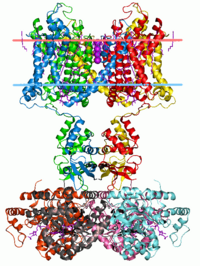Delayed rectifier outward potassium current
| Eukaryotic potassium channel | |||||||||
|---|---|---|---|---|---|---|---|---|---|

Potassium channel, structure in a membrane-like environment. Calculated hydrocarbon boundaries of the lipid bilayer are indicated by red and blue dots.
|
|||||||||
| Identifiers | |||||||||
| Symbol | Ion_trans | ||||||||
| Pfam | PF00520 | ||||||||
| InterPro | IPR005821 | ||||||||
| SCOP | 1bl8 | ||||||||
| SUPERFAMILY | 1bl8 | ||||||||
| TCDB | 1.A.1 | ||||||||
| OPM superfamily | 8 | ||||||||
| OPM protein | 2a79 | ||||||||
|
|||||||||
| Available protein structures: | |
|---|---|
| Pfam | structures |
| PDB | RCSB PDB; PDBe; PDBj |
| PDBsum | structure summary |
| Ion channel (bacterial) | |||||||||
|---|---|---|---|---|---|---|---|---|---|

Potassium channel KcsA. Calculated hydrocarbon boundaries of the lipid bilayer are indicated by red and blue dots.
|
|||||||||
| Identifiers | |||||||||
| Symbol | Ion_trans_2 | ||||||||
| Pfam | PF07885 | ||||||||
| InterPro | IPR013099 | ||||||||
| SCOP | 1bl8 | ||||||||
| SUPERFAMILY | 1bl8 | ||||||||
| OPM protein | 1r3j | ||||||||
|
|||||||||
| Available protein structures: | |
|---|---|
| Pfam | structures |
| PDB | RCSB PDB; PDBe; PDBj |
| PDBsum | structure summary |
| Slow voltage-gated potassium channel (Potassium channel, voltage-dependent, beta subunit, KCNE) | |||||||||
|---|---|---|---|---|---|---|---|---|---|
| Identifiers | |||||||||
| Symbol | ISK_Channel | ||||||||
| Pfam | PF02060 | ||||||||
| InterPro | IPR000369 | ||||||||
| TCDB | 8.A.10 | ||||||||
|
|||||||||
| Available protein structures: | |
|---|---|
| Pfam | structures |
| PDB | RCSB PDB; PDBe; PDBj |
| PDBsum | structure summary |
| KCNQ voltage-gated potassium channe | |||||||||
|---|---|---|---|---|---|---|---|---|---|
| Identifiers | |||||||||
| Symbol | KCNQ_channel | ||||||||
| Pfam | PF03520 | ||||||||
| InterPro | IPR013821 | ||||||||
|
|||||||||
| Available protein structures: | |
|---|---|
| Pfam | structures |
| PDB | RCSB PDB; PDBe; PDBj |
| PDBsum | structure summary |
| Kv2 voltage-gated K+ channel | |||||||||
|---|---|---|---|---|---|---|---|---|---|
| Identifiers | |||||||||
| Symbol | Kv2channel | ||||||||
| Pfam | PF03521 | ||||||||
| InterPro | IPR003973 | ||||||||
|
|||||||||
| Available protein structures: | |
|---|---|
| Pfam | structures |
| PDB | RCSB PDB; PDBe; PDBj |
| PDBsum | structure summary |
Voltage-gated potassium channels (VGKCs) are transmembrane channels specific for potassium and sensitive to voltage changes in the cell's membrane potential. During action potentials, they play a crucial role in returning the depolarized cell to a resting state.
Alpha subunits form the actual conductance pore. Based on sequence homology of the hydrophobic transmembrane cores, the alpha subunits of voltage-gated potassium channels are grouped into 12 classes. These are labeled Kvα1-12. The following is a list of the 40 known human voltage-gated potassium channel alpha subunits grouped first according to function and then subgrouped according to the Kv sequence homology classification scheme:
slowly inactivating or non-inactivating
rapidly inactivating
Passes current more easily in the inward direction (into the cell, from outside).
Unable to form functional channels as homotetramers but instead heterotetramerize with Kvα2 family members to form conductive channels.
Beta subunits are auxiliary proteins that associate with alpha subunits, sometimes in a α4β4stoichiometry. These subunits do not conduct current on their own but rather modulate the activity of Kv channels.
Proteins minK and MiRP1 are putative hERG beta subunits.
The voltage-gated K+ channels that provide the outward currents of action potentials have similarities to bacterial K+ channels.
These channels have been studied by X-ray diffraction, allowing determination of structural features at atomic resolution.
The function of these channels is explored by electrophysiological studies.
Genetic approaches include screening for behavioral changes in animals with mutations in K+ channel genes. Such genetic methods allowed the genetic identification of the "Shaker" K+ channel gene in Drosophila before ion channel gene sequences were well known.
Study of the altered properties of voltage-gated K+ channel proteins produced by mutated genes has helped reveal the functional roles of K+ channel protein domains and even individual amino acids within their structures.
...
Wikipedia
